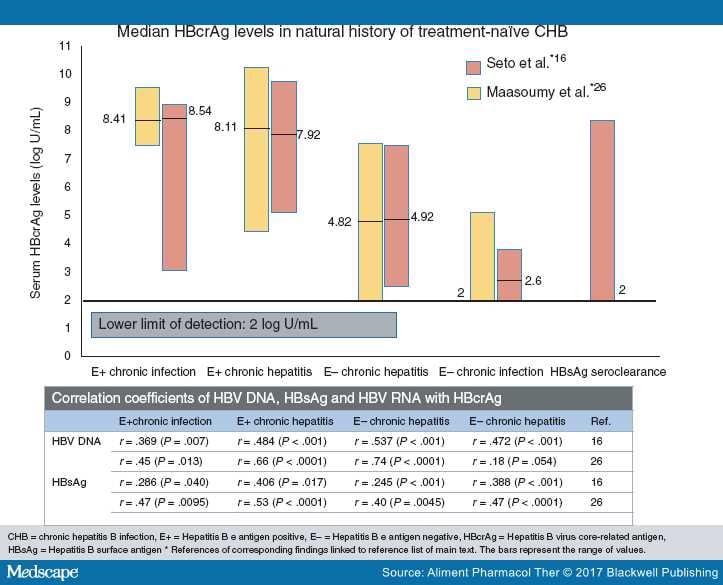|
 
- 现金
- 62111 元
- 精华
- 26
- 帖子
- 30437
- 注册时间
- 2009-10-5
- 最后登录
- 2022-12-28

|
Profile of HBcrAg in the Natural History of Chb
The profiles were well characterized by 2 landmark studies performed in treatment-naïve Asian (N = 404) and European (N = 249) CHB patients across genotypes AD. [16,26] In both studies, the HBcrAg levels differed significantly between HBeAg-positive and -negative patients. In general, HBeAg-positive patients have a higher HBcrAg level compared to HBeAg-negative patients (Figure 2). is related to the diminished production of HBeAg after HBeAg seroconversion. Specifically, in HBeAg-positive patients, the HBcrAg levels were 8.54 and 7.92 log U / mL in HBeAg-positive chronic infection (also known as immunotolerant phase) and HBeAg-positive chronic hepatitis (also known as immune clearance phase) respectively (P <.001). [16] It suggests that HBeAg-positive patients with lower HBcrAg levels are more likely to be under a more intense immune control. els can reflect immune clearance activity deserves more future studies to examine.
Click to zoom
(Enlarge Image)
Figure 2.
Median HBcrAg levels in natural history of CHB and correlation with other viral markers
For HBeAg-negative patients, the HBcrAg levels were significantly lower in HBeAg-negative chronic infection (also known as inactive carrier state) patients compared to HBeAg- negative chronic hepatitis (also known as HBeAg-negative active phase) patients (2.60 vs. 4.92 log (Figure 2). [16] A higher HBcrAg in HBeAg-negative chronic hepatitis compared to HBeAg-negative chronic infection was associated with more significant necroinflammatory activity and significant fibrosis. [27] D in HBeAg-positive phase, if HBeAg-negative patients (although with lower HBcrAg level compared with HBeAg-positive patients) still have relatively high HBcrAg levels after HBeAg seroconversion, the disease activities are in fact more advanced.
For patients who underwent spontaneous HBsAg seroclearance, most of them (79%) had undetectable HBcrAg levels signifying a more quiescent disease state. Of the 21% still having detectable HBcrAg in the serum, the median HBcrAg was 2.7 log U / mL. [16 , 28]
All of the above findings offer a potential role for HBcrAg to further define the phases of CHB infection, although the optimal cut-offs remain determined. The latest EASL guideline acknowledged the potential of HBcrAg to help define the phase of chronic HBV infection, especially in HBeAg-negative patients. [7]
In addition, HBcrAg may be useful in predicting important milestones in natural history of CHB infection such as HBeAg seroconversion. A number of host and virological factors are found to be favorarable for spontaneous HBeAg seroconversion, including alanine aminotransferase (ALT)> 2 times the upper limit of normal (ULN), low HBV DNA, low HBsAg titre, non-C genotype and low serum interleukin-27 levels. [29-33] More recently, HBcrAg has been shown to be predictive of early spontaneous HBeAg seroconversion at 12 months in a Japanese study (N = 234) with an area under receiver-operating-characteristic (ROC) curve (AUROC) of 0.708. [34] In another Chinese study of 113 patients, the HBcrAg levels at week 28 of follow-up were significantly lower for patients in the HBeAg-positive chronic hepatitis phase who underwent spontaneous HBeAg seroconversion compared to those who did not (4.32 vs. 5.16 log U / mL, respectively; P = .004). To predict spontaneous HBeAg seroconversion, baseline HBcrAg lev The results were as follows: el below 4.9 log U / mL or a decline of HBcrAg by ≥ 2 logs at week 28 would confer positive predictive values (PPV) of 73.9% and 76.2% respectively, and negative predictive values (NPV) of 96.7% and 93.8% respectively. [35] Whether HBcrAg levels can be predictive of spontaneous HBsAg seroclearance remains to be determined. |
|